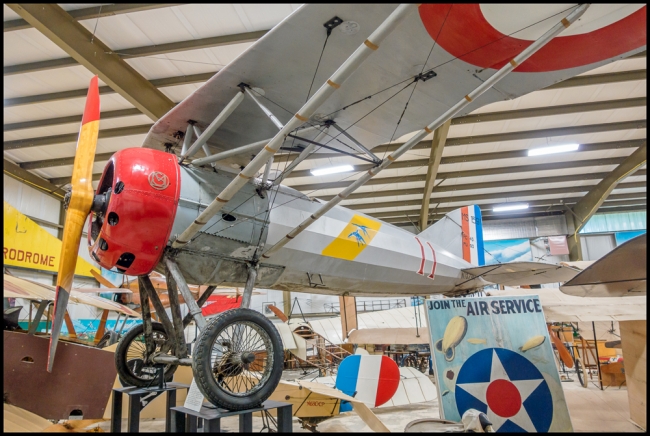According to the Military History Encyclopedia on the Web:
The Morane-Saulnier Type AI was a single seat parasol-wing fighter developed during 1917 and that entered service early in 1918, but that had to be withdrawn after a number of wing failures.
During 1916 Morane-Saulnier had attempted to produce a single-seat version of their Type P parasol reconnaissance aircraft, but without success. The company then moved on to develop two entirely new single seat fighters, the biplane Type AF and the parasol-wing Type AI.
The new aircraft was of largely conventional construction. The fuselage had a circular cross section, but was constructed around a wooden framework, not as a monocoque (an experimental monocoque version was produced during 1917). The flat wing was swept back, with a section cut out in the rear centre to improve the pilot’s view. It was supported by parallel lift struts which ran from the base of the fuselage to a point two thirds of the way along the wing, and that were braced with one pair of compression struts. Strength tests on the wing showed that it should have been totally safe.
Both the Type AI and Type AF were powered by a 150hp Gnome Monosoupape rotary engine. Earlier Morane-Saulnier aircraft had been given very large propeller spinners, but on the AI this was removed and replaced with a well designed annular cowling.
The first prototype was armed with a single 7.7mm synchronized Vickers machine gun, and was given the official designation MoS 27.C1. It underwent official tests at Villacoublay on 7-9 August 1917, with Eugéne Gilbert at the controls. During this trials the aircraft reached a top speed of 135mph at 9,840ft, and took 7 minutes 25 seconds to reach that altitude. Handling trials, with Lt René Labouchère at the controls, followed on 11 September, and the new aircraft was judged to be very manoeuvrable and responsible to controls, with an excellent view from the cockpit.
Work on a second version, armed with two Vickers guns, was carried out at about the same time and this aircraft, the MoS 29.C1, underwent official trials at Villacoublay on 8 September. It had larger tail surfaces which reduced its climbing speed, but was otherwise similar to the MoS 27.
The Royal Flying Corps was informed of the new aircraft by the British Aviation Commission in Paris on 12 August 1917, in a report that described its rigid parasol wing but didn’t mention that it was a single seat fighter. Trenchard decided that he didn’t want the new aircraft, and none were produced for the British.
The Type AI was ordered in large numbers by the French, and as many as 1,210 were produced. It entered service early in 1918, and three escadrilles converted to the new aircraft, changing designations as they did. Escadrille N.156 was first, becoming MSP.156 on 9 February. N.161 followed, becoming MSP.161 on 21 February, and N.158 was last to make the change, becoming MSP.158 on 4 March.
The new fighter was popular with its pilots, who liked its speed and manoeuvrability, but in service conditions the parasol wing proved to be dangerously weak. A number of aircraft were lost when their wings either came off or folding in the air – in one example Lt. Jean Coutary was killed when his aircraft lost its wing over his airfield on 26 February, and other aircraft suffered the same fate in combat. The reason was unclear, but was probably related to wing flutter or a similar phenomenon not then understood. By mid-May the Type AI had been withdrawn from front line service.
Morane-Saulnier responded by converting the Type AI into an single seat advanced trainer. Two versions were produced, the MoS 30.E1 with a 120-135hp Le Rhône engine and the MoS 30bis.E1 with a 90-95 hp engine. The guns were removed and fuel capacity reduced. Supplementary wing bracing was also introduced.
The MoS 30 was used in large numbers by the French. Fifty one MoS 30.E1s were purchased by the US Air Service in France, and were used at their training base at Issoudun. After the war three were sold to Belgium, while single aircraft went to Japan, Switzerland and the Soviet Union.
Taken with a Sony RX-100 M3.

